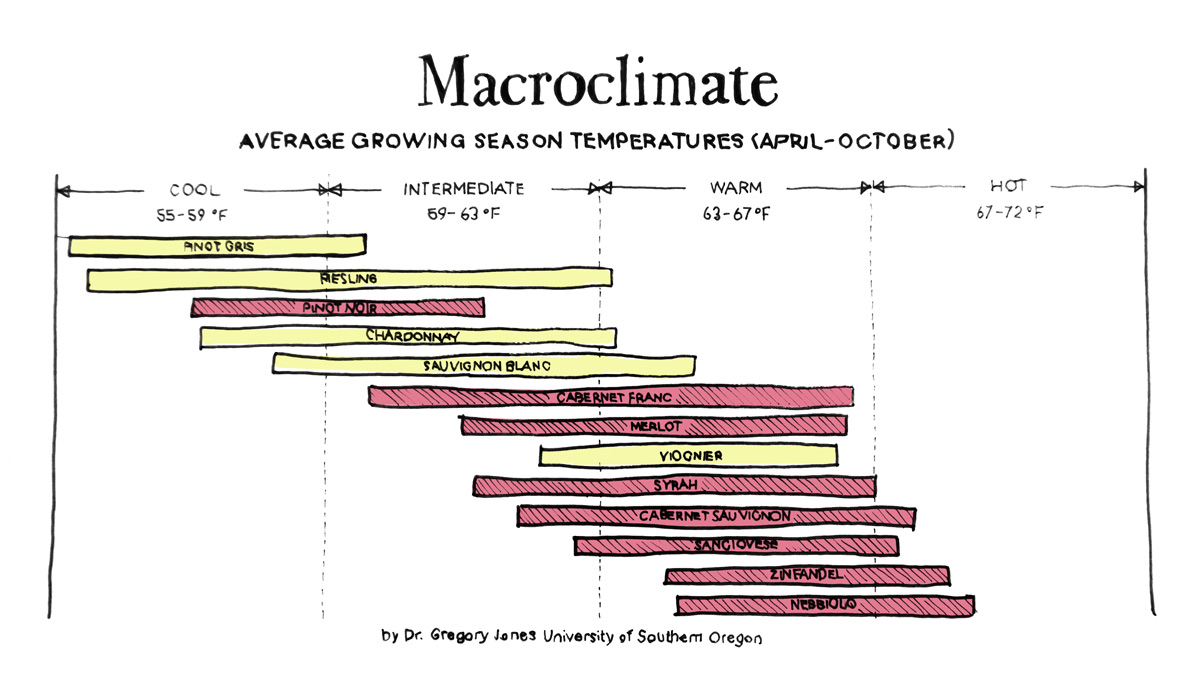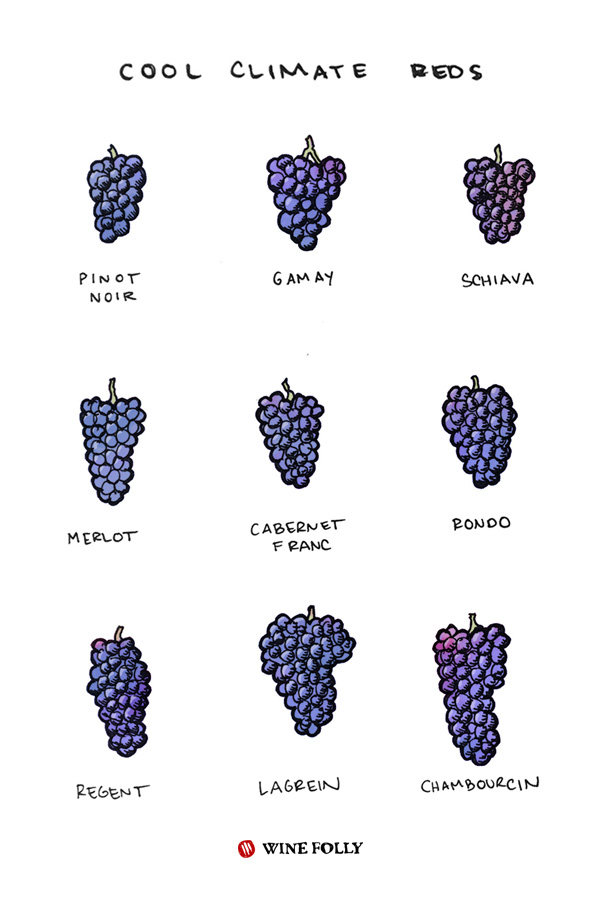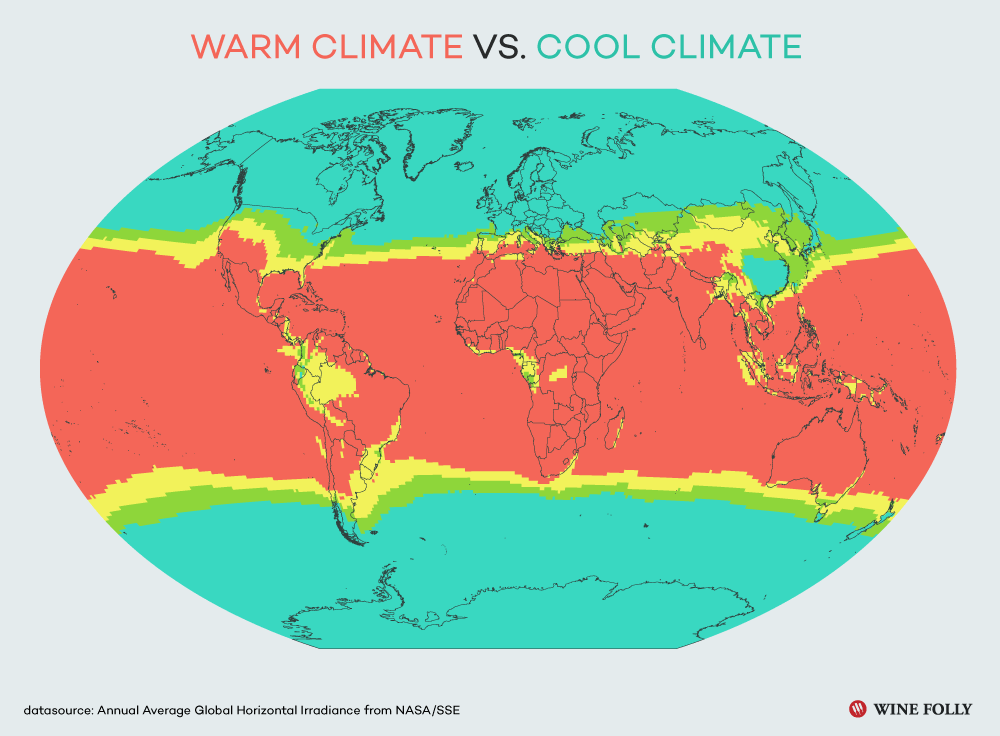The climate greatly affects what wines grow and how they taste. The term “cool climate” refers to wine regions which specialize in varieties like Chardonnay, Pinot Noir, and Sauvignon Blanc.
Cool Climate Wines
Certain wine varieties will not fully ripen if grown in a cool climate. For example, you’ll rarely, if ever, find grapes like Grenache and Cabernet Sauvignon growing successfully in a cooler region. Instead, expect to find more white wine varieties and elegant or aromatic reds. Here are a few examples of varieties that produce exceptional wines when grown in a cool climate:
Red Wines
Pinot Noir, Gamay, Schiava, Merlot, Cabernet Franc, Rondo, Regent, Lagrein, Chambourcin
Red wines from cool climates tend to have higher acidity, taste more spicy, have lower alcohol, and a lighter body.

White Wines
Müller-Thurgau, Sauvignon Blanc, Chardonnay, Chasselas, Pinot Gris, Riesling, Madeleine Angevine, Bacchus, Solaris
White wines from cool climates tend to have higher acidity, more lemon-lime aromas, and are typically lower alcohol, with a very light body.
Cool Climate Wine Regions
Different wine varieties prefer different climates. This observation was made back in 2006, when a climatologist named Dr. Gregory V. Jones studied how climate variations influenced vine growing. The results of his work outlined four primary climate types for grape growing and the wine varieties best suited for each climate.

According to Jones, cool climate wine regions have average growing season temperatures of 55–59 ºF (13–15 ºC) and 850–1389 growing degree-days (Winkler Index). Want to know if a region has a cool climate? Generally you’ll find that cool climate regions have all four seasons, cooler summer days, and a shorter growing season.
A few examples of cooler climate wine growing regions may include:
- Marlborough, New Zealand: A region that specializes in zippy and lean Sauvignon Blanc wines.
- Chablis, France: A region in Burgundy that specializes in a lean, zippy style of Chardonnay that’s usually unoaked.
- Willamette Valley, Oregon: A region known for its more elegant Pinot Noir and fruity Pinot Gris wines.
- Trentino-Alto Adige, Italy: Valleys in the foothills of the Italian Alps specializing in minerally white and sparkling wines.
- Mosel, Germany: A steep river valley in Germany that produces high-quality Riesling wines.
- Okanagan Valley, Canada: A dry, northern-latitude region of British Columbia specializing in Merlot, Chardonnay, Riesling and Pinot Gris
- Champagne, France: A cool region specializing in sparkling wines made with Chardonnay, Pinot Noir and Pinot Meunier
Climate Change Is Making New Cool Climate Wine Regions
With climate change, you can expect wine regions that are currently “cool” to become warmer and regions that were once to cool to grow grapes to be able to grow grapes. Regions which are now starting to produce potentially great cool climate wines include:
- Michigan, USA: Riesling, Pinot Gris, Chambourcin, and other French-Hybrids
- Poland: Riesling, Chardonnay, Pinot Noir
- Denmark: Rondo, Müller-Thurgau, Solaris
- Netherlands: Chardonnay, Pinot Gris, Müller-Thurgau
- Sweden: Chardonnay, Vidal, Regent, Solaris
- Puget Sound, Washington: Müller-Thurgau, Madeleine Angevine, Melon
- England: Chardonnay, Pinot Noir, Bacchus
- Nova Scotia, Canada: Cabernet Franc, Chardonnay
- Tasmania, Australia: Pinot Noir, Chardonnay, Sauvignon Blanc


